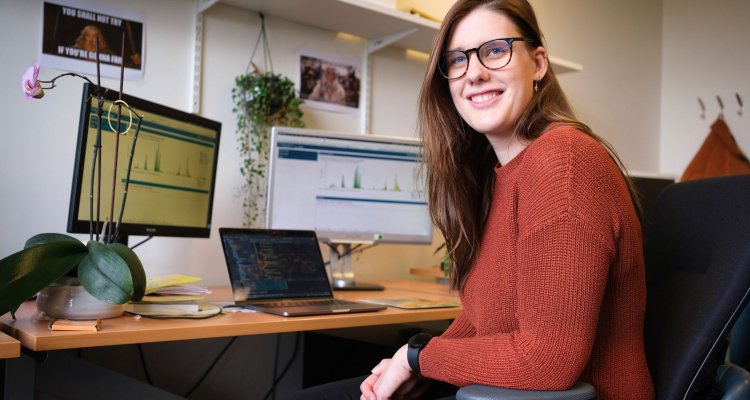
Interview
Zooming in on microbiomes: ‘Bacterial genes can be the building blocks for new antibiotics’
Researchers believe bacteria still contain many more undiscovered genes and other particles that could be used for the development of medicines. Hannah Augustijn, a bioinformatician, is developing software to make that search easier.
Zooming in on microbiomes
Bacteria, fungi and other micro-organisms do not exist in isolation. All over the world, in plants, animals and in soil, they form communities, known as microbiomes. As part of the Dies Natalis, we’re putting the spotlight on this topic through the work of three young researchers.
This is the second story in the series. Read the previous story about researching intestinal bacteria of babies.
‘I was looking for genes that act as a kind of on/off switch for processes, and I found one,’ says Hannah Augustijn, a researcher in the Bioinformatics chair group. The gene cluster is located in bacteria that coalesce with other miniscule organisms to form microbiomes. ‘A microbiome is more than just a group of microorganisms. It’s also a set of interactions.’
‘Those internal connections benefit their hosts, or each other. Or they can actually work against each other and compete for nutrients. We still know very little about the genes and molecules that regulate this.’ These unknowns are precisely what fascinate her: from a scientific point of view, it’s a gold mine. ‘I want to develop innovative methods to discover that gold mine.’
Software development
Augustijn took existing software and expanded it with a new tool for finding on/off switches in the genetic code of bacteria. The model predicted the location of the switch for iron uptake by the bacteria, and that’s how she discovered the gene cluster. She then moved from her computer to the laboratory to test the functioning of the gene cluster. ‘I was able to demonstrate that the computer programme was right. The prediction corresponded exactly with the reality.’
Augustijn says she is obviously delighted at having found this evidence for “her” gene cluster. But she is actually most proud of another aspect of her work. ‘My project is all about software and website development. Researchers all over the world tell me what they need. I then try to build that. It’s always a puzzle for me to solve, and then I use a website to share my findings. By doing that, I make it easier for other researchers to do their work. It's great to then see that they actually use my tool.’
Accelerating the development of medicines
New DNA techniques and software are making it easier and easier to investigate microbiomes and all their internal interactions, Augustijn explains. ‘You discover a molecule or gene that is promising for the development of antibiotics, cancer drugs, or natural crop protection faster from large amounts of data. I think it’s great that my research is going to contribute to this in the future. I’m working on the foundations for that.’ And if her contribution to the computer programme helps bring a new medicine to market, will she know about it? ‘The software is used so much around the world, it’s impossible for the developers to keep up,’ she laughs.
Hannah Augustijn

Hannah Augustijn (28) is a PhD candidate in the Bioinformatics chair group and is also affiliated with Leiden University.
I conduct foundational research for the development of antibiotics, cancer treatment drugs and natural crop protection.